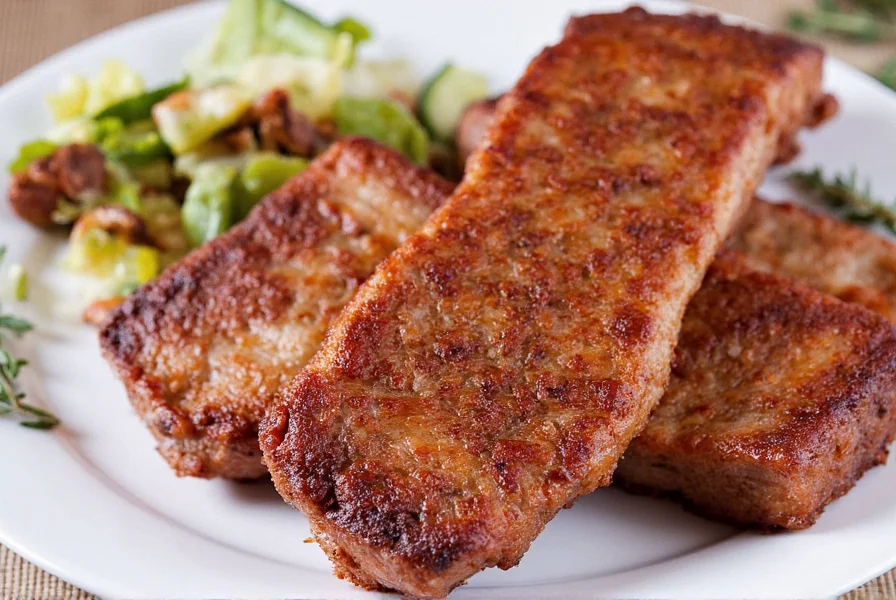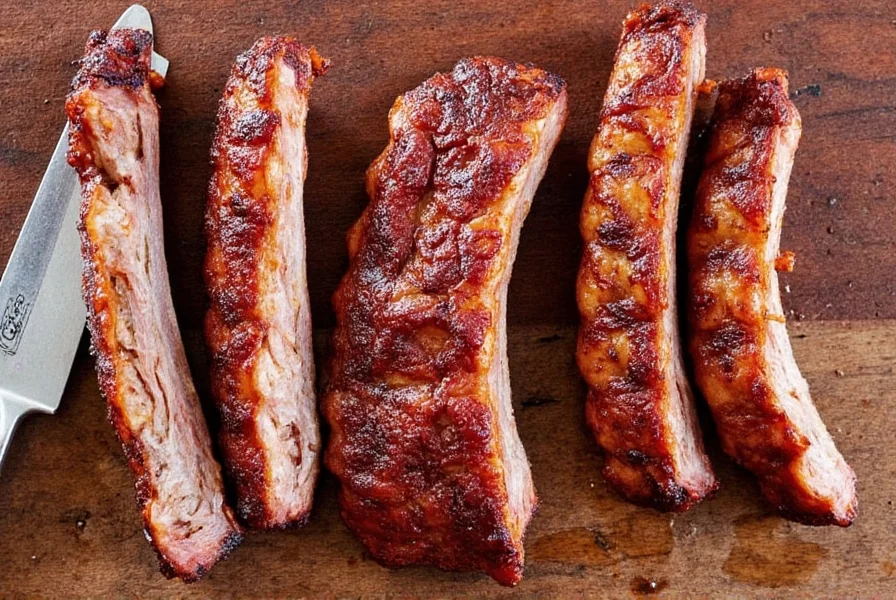Get restaurant-quality smoked St. Louis ribs at home with this foolproof recipe. In just 5-6 hours, you'll achieve fall-off-the-bone tenderness with perfect smoke ring. Follow these key steps: trim ribs, apply dry rub, smoke at 225°F-250°F for 3 hours, wrap with apple juice for 2 hours, glaze for 30 minutes, and rest 15-20 minutes.
Table of Contents
- What Are St. Louis Style Ribs?
- Why Smoke St. Louis Ribs?
- Essential Equipment for Smoking Ribs
- St. Louis Ribs Ingredients List
- Step-by-Step Smoked St. Louis Ribs Recipe
- Tips & Tricks for Perfect Ribs Every Time
- Buying Guide: Choosing the Best Ribs and Accessories
- Frequently Asked Questions
- Final Thoughts
What Are St. Louis Style Ribs?
St. Louis style ribs are trimmed spareribs cut from the belly side of the pig, offering more fat marbling and deeper flavor than baby back ribs. This cut is ideal for smoking due to its balanced meat-to-bone ratio and consistent shape.
| Rib Type | Location | Fat Content | Texture |
|---|---|---|---|
| St. Louis Ribs | Below the baby backs (belly side) | Higher | Meatier, more flavorful |
| Baby Back Ribs | Along the spine under the loin | Lower | Tenderer, leaner |
Why Smoke St. Louis Ribs?

Smoking is ideal for St. Louis ribs because their higher fat content benefits from low-and-slow cooking. This method breaks down connective tissues while infusing rich smoke flavor, resulting in tender, juicy ribs with a perfect smoke ring. Key advantages include:
- Enhanced flavor penetration from smoke
- Consistent tenderness throughout the meat
- Perfect caramelization of rub and sauce
- Moisture retention during long cooking process
Essential Equipment for Smoking Ribs
Here's what you need for perfect results:
- Smoker: Offset, pellet, or electric smoker that maintains steady 225°F-250°F temperatures
- Probe Thermometer: Digital thermometer with probe for monitoring internal rib temperature (195°F-203°F)
- Wood Chips: Hickory for bold flavor, applewood for sweetness, or cherry for mild smoke
- Butcher Paper: Food-safe, uncoated paper for the Texas Crutch phase
- Tongs & Cutting Board: For handling ribs without tearing
St. Louis Ribs Ingredients List
- 1 full rack of St. Louis style ribs (2.5-3 lbs)
- 2 tbsp brown sugar
- 1 tbsp paprika
- 1 tbsp garlic powder
- 1 tbsp onion powder
- 1 tsp black pepper
- 1 tsp salt
- 1/2 tsp cayenne (optional for heat)
- 1/4 cup apple juice or apple cider vinegar (for wrapping)
- Your favorite BBQ sauce (Kansas City style recommended)
Step-by-Step Smoked St. Louis Ribs Recipe
- Trim & Prep: Remove silver skin membrane from bone side using butter knife. Trim excess fat for even cooking.
- Apply Dry Rub: Massage spice mixture evenly over all sides. Let sit 30 minutes for flavor absorption.
- Preheat Smoker: Set to 225°F-250°F with soaked wood chips. Maintain consistent temperature throughout.
- Initial Smoke: Place ribs bone-side down. Smoke for 3 hours without opening smoker.
- Texas Crutch: Wrap tightly in butcher paper with 2 tbsp apple juice. Return to smoker for 2 hours.
- Glaze: Unwrap, apply BBQ sauce generously. Smoke 30 minutes until sauce sets.
- Rest & Serve: Rest ribs 15-20 minutes before slicing. Test doneness with bend test (rack bends easily without snapping).
Tips & Tricks for Perfect Ribs Every Time

- Temperature Control: Use smoker thermometer to maintain 225°F-250°F. Fluctuations cause tough ribs.
- Don't Skip Membrane Removal: This prevents rub penetration and ensures tenderness.
- Wood Selection: Hickory for classic BBQ, applewood for sweet notes, or cherry for mild flavor. Avoid mesquite for ribs.
- Moisture Management: Spray with apple juice every 45 minutes during initial smoke phase.
- Doneness Test: Use the bend test - rack should bend 90 degrees without breaking. Internal temp should be 195°F-203°F.
Buying Guide: Choosing the Best Ribs and Accessories
| Product | Description | Features | Best For | Occasion |
|---|---|---|---|---|
| St. Louis Ribs (Choice Grade) | Trimmed pork spareribs | Uniform size, good marbling, no membrane | Beginner to pro smokers | Weekend cookouts, BBQ contests |
| Offset Smoker (Char-Griller) | Affordable and versatile charcoal + wood smoker | Durable steel, adjustable vents, dual grates | Backyard enthusiasts | Home use, gatherings |
| Instant Read Thermometer | Digital thermometer for checking doneness | Fast readings, waterproof, easy to calibrate | All skill levels | Cookouts, competitions |
| Applewood Chips | Natural hardwood chips for subtle smoke flavor | Soakable, consistent size, clean burn | Smokers looking for sweet, mild smoke | Summer parties, family dinners |
| Butcher Paper Rolls | Uncoated food-safe paper for wrapping meats | Porous texture, heat-resistant, eco-friendly | Low and slow smokers | Long cooks, brisket, ribs |
Frequently Asked Questions
- How do I know when my ribs are done? Use the bend test: pick up rack with tongs and see if it bends easily without snapping. Internal temperature should be 195°F-203°F. Meat should pull back from bones slightly.
- What's the best wood for smoking St. Louis ribs? Hickory for classic BBQ flavor, applewood for sweet notes, or cherry for mild smoke. Many pitmasters combine hickory (base) with fruit wood (finish).
- Why are my smoked ribs tough? Tough ribs usually mean insufficient cooking time or temperature fluctuations. St. Louis ribs need 5-6 hours at 225°F-250°F to break down connective tissues. Also, never skip membrane removal.
- Can I use baby back ribs instead of St. Louis style? Yes, but reduce cooking time by 1-1.5 hours. Baby backs are leaner and dry out faster. Use same temperature but monitor closely.
- How do I smoke ribs without drying out? Maintain consistent smoker temperature (225°F-250°F), use the Texas Crutch (wrapping with apple juice), and spray with apple juice every 45 minutes during initial smoke phase.
- Should I wrap my ribs during smoking? Yes, wrapping in butcher paper with apple juice locks in moisture and speeds cooking. This is crucial for St. Louis ribs due to their fat content.
- What temperature should I smoke ribs at? Maintain steady 225°F-250°F throughout. Higher temperatures cause tough meat; lower temperatures extend cooking time unnecessarily.
- How do I store leftover ribs? Store in airtight container in fridge for 3-4 days or freeze for 3 months. Reheat wrapped in foil at 275°F until warmed through.
- Can I use a gas grill for smoking ribs? Yes, but use a smoker box with wood chips and monitor temperature closely. Gas grills struggle to maintain consistent low temps below 250°F.
- Do I need to remove the membrane from St. Louis ribs? Absolutely. The membrane prevents rub penetration and makes ribs tough. Use a butter knife to lift edge, then grab with paper towel and peel off completely.
Final Thoughts
Perfect smoked St. Louis ribs are achievable with the right technique and patience. Focus on consistent temperature control, proper trimming, and moisture management for fall-off-the-bone tenderness every time. Remember: slow cooking is key - rushing the process results in tough ribs. Now fire up your smoker and enjoy restaurant-quality barbecue at home!










 浙公网安备
33010002000092号
浙公网安备
33010002000092号 浙B2-20120091-4
浙B2-20120091-4